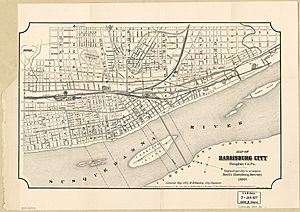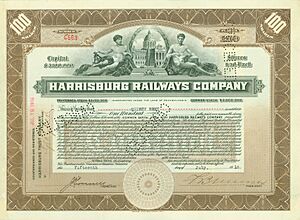Timeline of Harrisburg, Pennsylvania history facts for kids
This is a timeline of important events in the history of Harrisburg, Pennsylvania. It covers how the city grew from a small trading post to the capital of Pennsylvania, highlighting key moments and changes over the centuries.
Contents
Early History of Harrisburg
- 1608: Captain John Smith met the Susquehannock Indians while exploring the Susquehanna River.
- Late 1600s: Peter Bisaillon, a French trader, was one of the first Europeans to explore this land. He helped as an interpreter between Native Americans and settlers.
- 1719: John Harris, Sr., a settler from England, established Harrisburg as a trading post.
- 1740: The Parson John Elder house was built. It is the oldest building still standing within Harrisburg's current city limits.
- 1766: John Harris, Jr. built a strong stone home, which you can still see today at 219 South Front Street.
- 1789: Harrisburg's first newspaper, The Harrisburgh Journal and the Weekly Advertiser, began publishing on September 9.
- 1792:
- Pennsylvania's canal era began, lasting until 1931.
- Another newspaper, The Oracle of Dauphin, was first printed by John Wyeth and John W. Allen.
Harrisburg in the 1800s
- 1812: Harrisburg became the state capital of Pennsylvania. This meant it was the main place for the state's government.
- 1818: Construction started on the first capitol building. It was finished in 1822.
- 1820:
- The first bridge in Harrisburg, the "Camelback Bridge" (a wooden, covered bridge), was built.
- The newspaper The Pennsylvania Intelligencer was started.
- The city's population was 2,990 people.
- 1822: The first Harrisburg State Capitol building was completed. It later burned down in 1897.
- 1831: The Cumberland Valley Railroad was finished.
- 1834:
- The Pennsylvania Canal opened in Harrisburg.
- Dauphin Deposit Bank was established.
- 1836: The first train arrived in Harrisburg, run by the Harrisburg, Mount Joy, and Lancaster RR.
- 1837: Harrisburg's first railroad station was built.
- 1847: President James K. Polk appointed Jonas K. Rudy as the first letter carrier for the city.
- 1850:
- Harrisburg's first anthracite furnace (Porter Furnace) was built. This furnace used a type of coal to make iron.
- The U.S. Census counted 1,376 homes and 7,834 people.
- 1851: The State Lunatic Hospital was built. It was one of the largest buildings in town.
- 1854:
- The newspaper Pennsylvania Patriot was started.
- The Harrisburg YMCA (Young Men's Christian Association) was established.
- The Pennsylvania RR line from Harrisburg to Pittsburgh was completed.
- 1857: A much larger railroad station was built.
- 1860:
- Harrisburg officially became an incorporated city.
- The West Harrisburg Market Company was formed, which later became the Broad Street Market.
- 1861-1865: Harrisburg played an active role during the American Civil War.
- 1861:
- The first horsecar (a streetcar pulled by horses) began operating.
- Camp Curtin was established nearby as a large training ground for the Union Army.
- 1867: Pennsylvania Steel Works, south of Harrisburg, was the first in the U.S. to produce steel ingots (blocks of steel) when ordered.
- 1869: The Historical Society of Dauphin County was founded to preserve local history.
- 1873:
- A company for horse-drawn passenger railways opened.
- The first street in Harrisburg was paved.
- 1877: City troops guarded the arsenal during the Great Railroad Strike of 1877.
- 1878: Telephones were installed in Harrisburg.
- 1880:
- Steelton became an incorporated town.
- The first lighting plant, installed by Thomas Edison, brought electricity to Harrisburg.
- 1885: Harrisburg celebrated its 100th birthday.
- 1888: The first electric trolley service began, serving Steelton, Allison Hill, and other parts of Harrisburg.
- 1890:
- The second major bridge, the Walnut Street Bridge, was completed.
- The Harrisburg City Library opened.
- 1891: The first Mulberry Street Bridge was completed, helping to develop Allison Hill as one of the first suburbs.
- 1897: The original Harrisburg State Capitol building burned down.
Harrisburg in the 1900s
- 1900-1920: The City Beautiful Movement took place. This was a plan to improve and make the city more beautiful, led by Mira Lloyd Dock.
- 1901: The Pennsylvania Canal was closed.
- 1902:
- The first automobile appeared in the city.
- The Camelback Bridge was partly destroyed by a flood.
- The Rockville Bridge was built.
- Vance McCormick was elected mayor, promising reforms.
- A new water filter plant was built on City Island.
- 1903:
- The damaged Camelback bridge was removed and replaced.
- The Hershey chocolate plant was planned nearby.
- Trolley service expanded to Linglestown, Hummelstown, and Dauphin.
- 1905:
- The Market Street Bridge was built where the old Camelback Bridge stood.
- Harrisburg's first movie theater opened.
- The city's first skyscraper, the United Trust Company building, was built.
- 1906: The new State Capitol building was officially opened.
- 1907: Hershey Park opened.
- 1910: The Bellevue Park neighborhood opened. It was the first planned neighborhood in Harrisburg.
- 1912: Construction began on the Riverwalk, a path along the river.
- 1913:
-
- The transit company was reorganized as "Harrisburg Railways."
- The Dock Street Dam was completed on the Susquehanna River.
- 1915: The Great Migration brought many Black workers to Harrisburg's steel mills.
- 1916:
- Bethlehem Steel took over the PA Steel Co in Steelton.
- The first Kipona Festival was held.
- 1918: The Penn-Harris Hotel was built.
- 1921: The Island Park bathing beach had 235,000 visitors in one year.
- 1924: The first radio station in Harrisburg began broadcasting.
- 1926: The Market Street Bridge was widened from two lanes to four.
- 1929-1939: The Great Depression affected Harrisburg, like the rest of the country.
- 1930: Bus service started replacing trolleys on some lines.
- 1931: Pennsylvania's Canal era ended. The Harrisburg Symphony Orchestra performed for the first time.
- 1933:
- The YMCA Central Branch opened on Front Street.
- More trolley lines were replaced by buses.
- The Hotel Hershey opened.
- 1939: On July 16, buses completely replaced trolleys in Harrisburg. The last Harrisburg Railways Trolley closed.
- 1941: The mansion of John Harris, Jr., became home to the Historical Society of Dauphin County.
- 1943:
- Aircraft manufacturer AMP (now TE Connectivity) moved to Harrisburg.
- The new Dauphin County Courthouse opened, designed in the Art Deco style.
- 1950: Harrisburg reached its largest population ever, with 89,554 people.
- 1952: The Harvey Taylor Bridge opened to help traffic flow to the west side of the river.
- 1958:
- 1959: Urban renewal projects led to the removal of streets and houses in Midtown and Fox Ridge for new commercial buildings.
- 1960:
- The historic governor's mansion was taken down to create a parking lot.
- The John Harris Bridge opened over the river.
- 1961: The Harrisburg Expressway opened, connecting Paxton Street to Hampden Township via the John Harris Bridge.
- 1966: Penn State opened its campus on the site of the former Olmstead Air Force Base.
- 1969: Protests and community tensions occurred during the summer.
- 1972: Severe flooding hit Harrisburg due to Hurricane Agnes.
- 1973:
- Urban renewal projects led to the demolition of the Penn-Harris Hotel.
- The city took over public bus service from the Harrisburg Railways Company.
- 1983: The Harrisburg metropolitan area was renamed the Harrisburg–Lebanon–Carlisle Metropolitan Statistical Area (MSA).
- 1996: A part of the Walnut Street Bridge on the West Shore collapsed due to rising flood waters from a major blizzard.
Harrisburg in the 2000s
- 2003: The metropolitan area was split into two separate areas: Harrisburg–Carlisle and Lebanon.
- 2010:
- Linda D. Thompson became the first female and first Black mayor of Harrisburg.
- The Harrisburg-York-Lebanon urban area was defined, connecting York County to the region.
- 2011: After facing financial difficulties, a state-appointed receiver (William B. Lynch) took control of the city's finances.
- 2013: The receiver released a plan that helped balance the city's budget by the late 2010s.
- 2018: Mayor Eric R. Papenfuse started the Vision Zero strategy. This plan aims to eliminate pedestrian deaths through better street design.
- 2020: Mayor Eric Papenfuse reorganized the Harrisburg Bureau of Police to improve community policing efforts.
- 2022: The city made its final payment on a large debt from 1997, setting it up to be debt-free the following year.
- 2023: A severe fire caused major damage to the brick building of the Broad Street Market on July 10.
|

All content from Kiddle encyclopedia articles (including the article images and facts) can be freely used under Attribution-ShareAlike license, unless stated otherwise. Cite this article:
Timeline of Harrisburg, Pennsylvania history Facts for Kids. Kiddle Encyclopedia.


